Unauthorized Access Mitigation in VANETs
VerifiedAdded on 2019/09/20
|19
|4643
|441
Essay
AI Summary
Vehicular Ad Hoc Networks (VANETs) offer great potential in transportation systems, but security is a significant concern. Non-repudiation is essential to prevent disavowal attacks and identify attackers. Future research should focus on securing VANETs against intruder vehicles and various security attacks. Key challenges include distributing certificates securely, determining vehicle mobility patterns, and changing MAC addresses. Proper handling of these challenges can regularize the VANET system for public use.
Contribute Materials
Your contribution can guide someone’s learning journey. Share your
documents today.

VEHICULA AD-HOC NETWORK
Name:
Student Number:
Word count:
Name of the course:
Tutor name:
“VEHICULAR AD-HOC NETWORK:
CURRENT CHALLENGES, AND FUTURE
PERSPECTIVE”
1 | P a g e
Name:
Student Number:
Word count:
Name of the course:
Tutor name:
“VEHICULAR AD-HOC NETWORK:
CURRENT CHALLENGES, AND FUTURE
PERSPECTIVE”
1 | P a g e
Secure Best Marks with AI Grader
Need help grading? Try our AI Grader for instant feedback on your assignments.
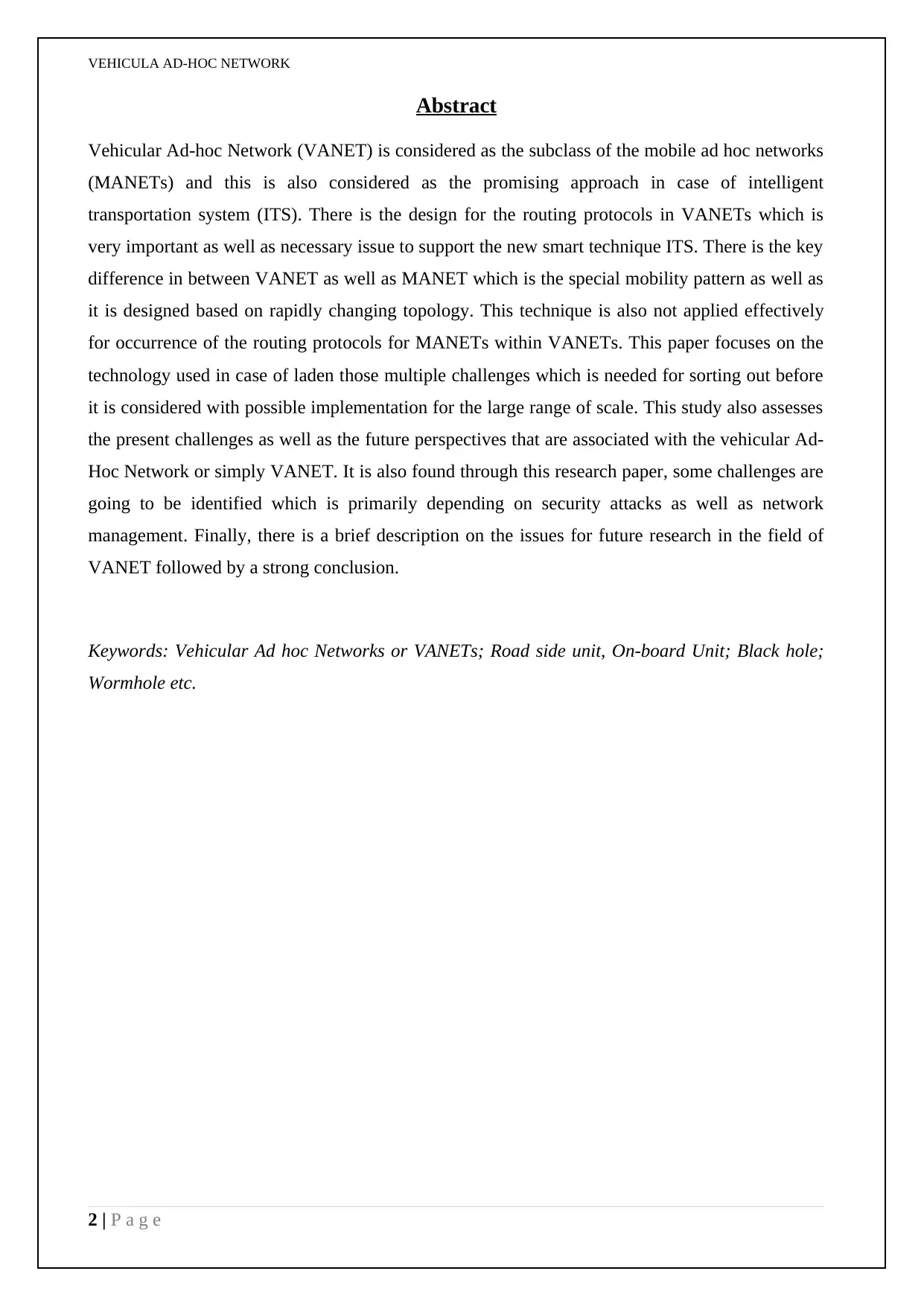
VEHICULA AD-HOC NETWORK
Abstract
Vehicular Ad-hoc Network (VANET) is considered as the subclass of the mobile ad hoc networks
(MANETs) and this is also considered as the promising approach in case of intelligent
transportation system (ITS). There is the design for the routing protocols in VANETs which is
very important as well as necessary issue to support the new smart technique ITS. There is the key
difference in between VANET as well as MANET which is the special mobility pattern as well as
it is designed based on rapidly changing topology. This technique is also not applied effectively
for occurrence of the routing protocols for MANETs within VANETs. This paper focuses on the
technology used in case of laden those multiple challenges which is needed for sorting out before
it is considered with possible implementation for the large range of scale. This study also assesses
the present challenges as well as the future perspectives that are associated with the vehicular Ad-
Hoc Network or simply VANET. It is also found through this research paper, some challenges are
going to be identified which is primarily depending on security attacks as well as network
management. Finally, there is a brief description on the issues for future research in the field of
VANET followed by a strong conclusion.
Keywords: Vehicular Ad hoc Networks or VANETs; Road side unit, On-board Unit; Black hole;
Wormhole etc.
2 | P a g e
Abstract
Vehicular Ad-hoc Network (VANET) is considered as the subclass of the mobile ad hoc networks
(MANETs) and this is also considered as the promising approach in case of intelligent
transportation system (ITS). There is the design for the routing protocols in VANETs which is
very important as well as necessary issue to support the new smart technique ITS. There is the key
difference in between VANET as well as MANET which is the special mobility pattern as well as
it is designed based on rapidly changing topology. This technique is also not applied effectively
for occurrence of the routing protocols for MANETs within VANETs. This paper focuses on the
technology used in case of laden those multiple challenges which is needed for sorting out before
it is considered with possible implementation for the large range of scale. This study also assesses
the present challenges as well as the future perspectives that are associated with the vehicular Ad-
Hoc Network or simply VANET. It is also found through this research paper, some challenges are
going to be identified which is primarily depending on security attacks as well as network
management. Finally, there is a brief description on the issues for future research in the field of
VANET followed by a strong conclusion.
Keywords: Vehicular Ad hoc Networks or VANETs; Road side unit, On-board Unit; Black hole;
Wormhole etc.
2 | P a g e

VEHICULA AD-HOC NETWORK
TABLE OF CONTENTS
Introduction........................................................................................................................................4
Background of the study....................................................................................................................4
Problem of the study..........................................................................................................................9
Possible security attacks.................................................................................................................9
Challenges in terms of network among vehicles.........................................................................14
Security Requirements.................................................................................................................15
Future research and Prospective......................................................................................................16
Conclusion.......................................................................................................................................17
Reference List..................................................................................................................................18
3 | P a g e
TABLE OF CONTENTS
Introduction........................................................................................................................................4
Background of the study....................................................................................................................4
Problem of the study..........................................................................................................................9
Possible security attacks.................................................................................................................9
Challenges in terms of network among vehicles.........................................................................14
Security Requirements.................................................................................................................15
Future research and Prospective......................................................................................................16
Conclusion.......................................................................................................................................17
Reference List..................................................................................................................................18
3 | P a g e
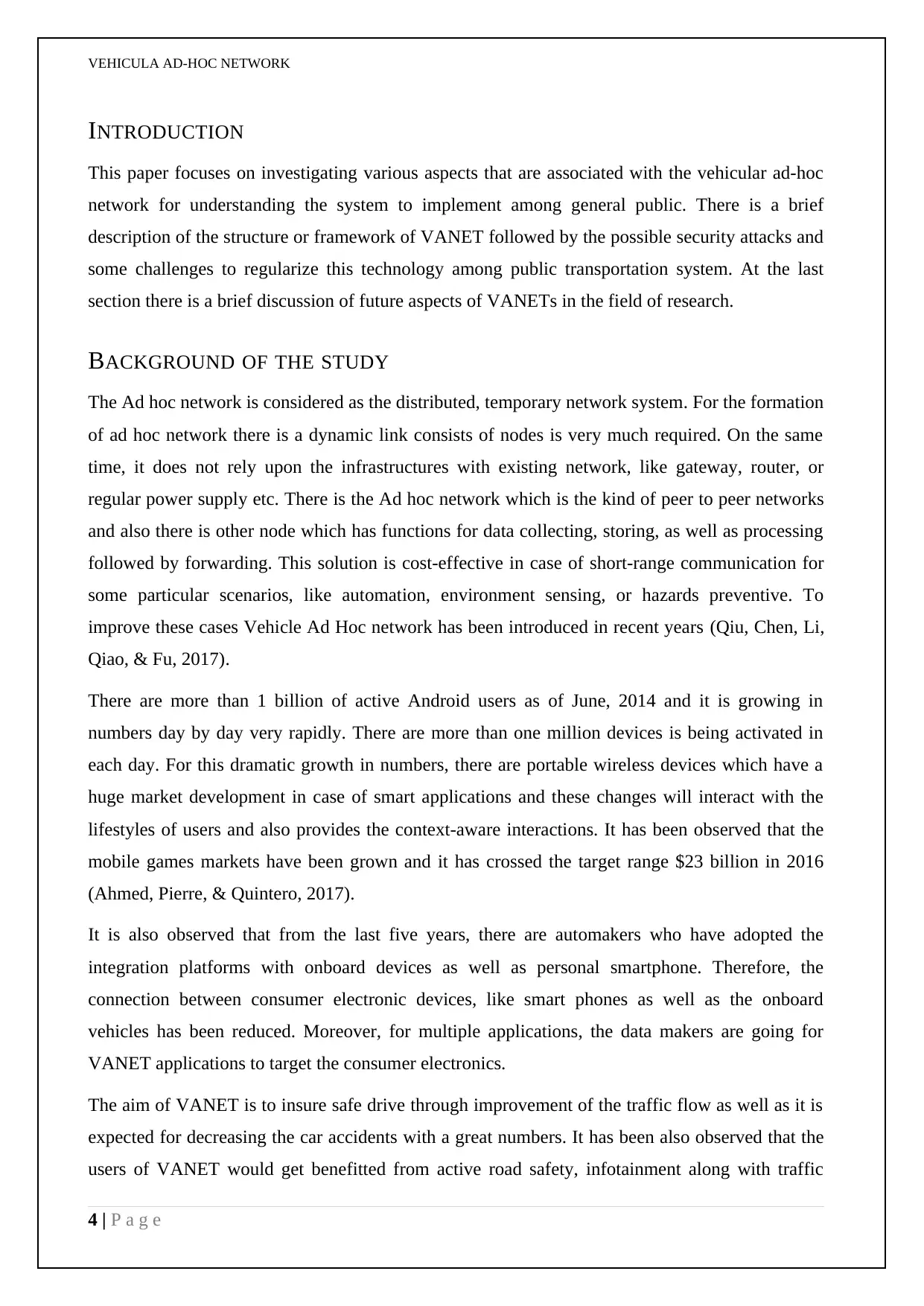
VEHICULA AD-HOC NETWORK
INTRODUCTION
This paper focuses on investigating various aspects that are associated with the vehicular ad-hoc
network for understanding the system to implement among general public. There is a brief
description of the structure or framework of VANET followed by the possible security attacks and
some challenges to regularize this technology among public transportation system. At the last
section there is a brief discussion of future aspects of VANETs in the field of research.
BACKGROUND OF THE STUDY
The Ad hoc network is considered as the distributed, temporary network system. For the formation
of ad hoc network there is a dynamic link consists of nodes is very much required. On the same
time, it does not rely upon the infrastructures with existing network, like gateway, router, or
regular power supply etc. There is the Ad hoc network which is the kind of peer to peer networks
and also there is other node which has functions for data collecting, storing, as well as processing
followed by forwarding. This solution is cost-effective in case of short-range communication for
some particular scenarios, like automation, environment sensing, or hazards preventive. To
improve these cases Vehicle Ad Hoc network has been introduced in recent years (Qiu, Chen, Li,
Qiao, & Fu, 2017).
There are more than 1 billion of active Android users as of June, 2014 and it is growing in
numbers day by day very rapidly. There are more than one million devices is being activated in
each day. For this dramatic growth in numbers, there are portable wireless devices which have a
huge market development in case of smart applications and these changes will interact with the
lifestyles of users and also provides the context-aware interactions. It has been observed that the
mobile games markets have been grown and it has crossed the target range $23 billion in 2016
(Ahmed, Pierre, & Quintero, 2017).
It is also observed that from the last five years, there are automakers who have adopted the
integration platforms with onboard devices as well as personal smartphone. Therefore, the
connection between consumer electronic devices, like smart phones as well as the onboard
vehicles has been reduced. Moreover, for multiple applications, the data makers are going for
VANET applications to target the consumer electronics.
The aim of VANET is to insure safe drive through improvement of the traffic flow as well as it is
expected for decreasing the car accidents with a great numbers. It has been also observed that the
users of VANET would get benefitted from active road safety, infotainment along with traffic
4 | P a g e
INTRODUCTION
This paper focuses on investigating various aspects that are associated with the vehicular ad-hoc
network for understanding the system to implement among general public. There is a brief
description of the structure or framework of VANET followed by the possible security attacks and
some challenges to regularize this technology among public transportation system. At the last
section there is a brief discussion of future aspects of VANETs in the field of research.
BACKGROUND OF THE STUDY
The Ad hoc network is considered as the distributed, temporary network system. For the formation
of ad hoc network there is a dynamic link consists of nodes is very much required. On the same
time, it does not rely upon the infrastructures with existing network, like gateway, router, or
regular power supply etc. There is the Ad hoc network which is the kind of peer to peer networks
and also there is other node which has functions for data collecting, storing, as well as processing
followed by forwarding. This solution is cost-effective in case of short-range communication for
some particular scenarios, like automation, environment sensing, or hazards preventive. To
improve these cases Vehicle Ad Hoc network has been introduced in recent years (Qiu, Chen, Li,
Qiao, & Fu, 2017).
There are more than 1 billion of active Android users as of June, 2014 and it is growing in
numbers day by day very rapidly. There are more than one million devices is being activated in
each day. For this dramatic growth in numbers, there are portable wireless devices which have a
huge market development in case of smart applications and these changes will interact with the
lifestyles of users and also provides the context-aware interactions. It has been observed that the
mobile games markets have been grown and it has crossed the target range $23 billion in 2016
(Ahmed, Pierre, & Quintero, 2017).
It is also observed that from the last five years, there are automakers who have adopted the
integration platforms with onboard devices as well as personal smartphone. Therefore, the
connection between consumer electronic devices, like smart phones as well as the onboard
vehicles has been reduced. Moreover, for multiple applications, the data makers are going for
VANET applications to target the consumer electronics.
The aim of VANET is to insure safe drive through improvement of the traffic flow as well as it is
expected for decreasing the car accidents with a great numbers. It has been also observed that the
users of VANET would get benefitted from active road safety, infotainment along with traffic
4 | P a g e
Paraphrase This Document
Need a fresh take? Get an instant paraphrase of this document with our AI Paraphraser
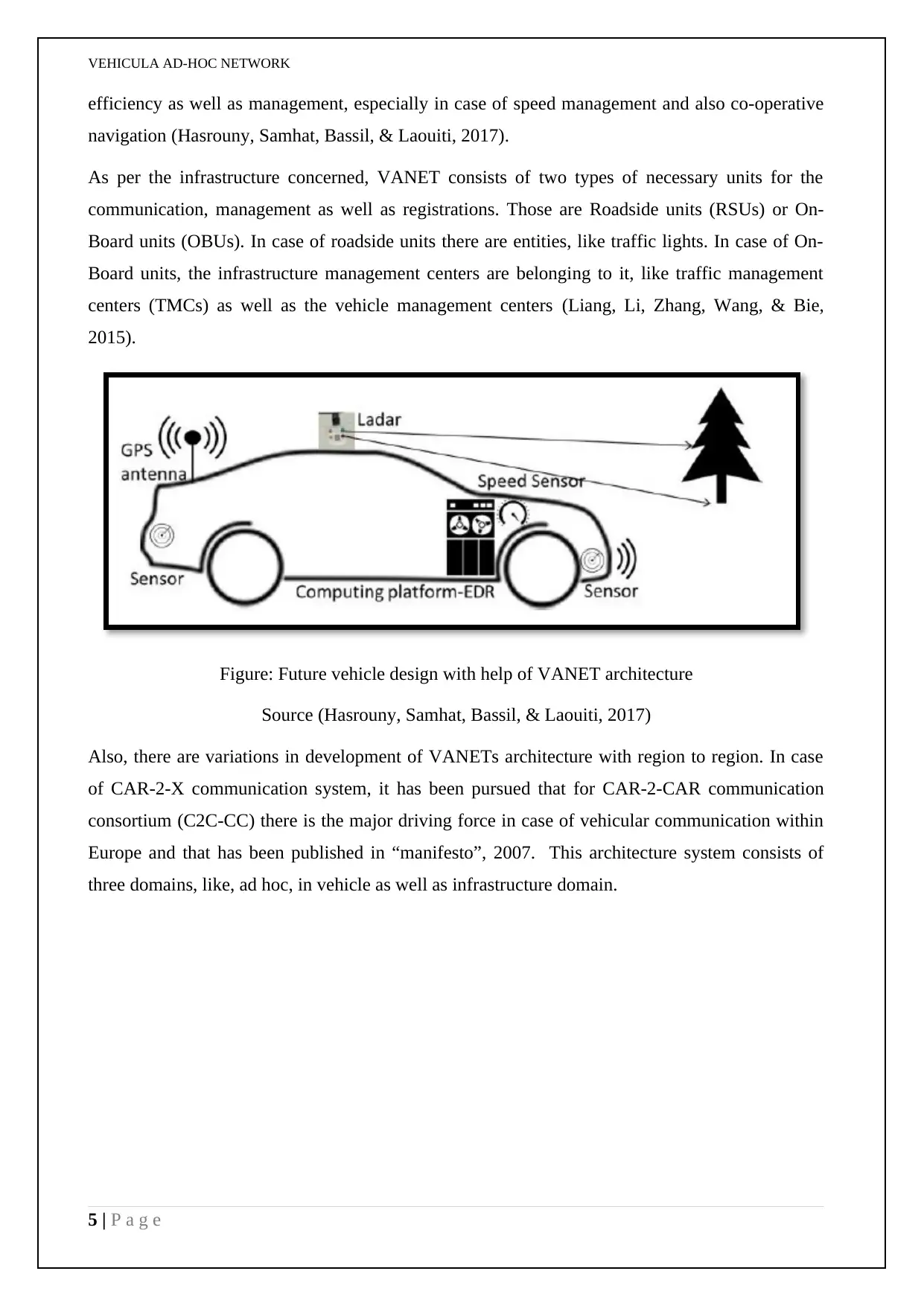
VEHICULA AD-HOC NETWORK
efficiency as well as management, especially in case of speed management and also co-operative
navigation (Hasrouny, Samhat, Bassil, & Laouiti, 2017).
As per the infrastructure concerned, VANET consists of two types of necessary units for the
communication, management as well as registrations. Those are Roadside units (RSUs) or On-
Board units (OBUs). In case of roadside units there are entities, like traffic lights. In case of On-
Board units, the infrastructure management centers are belonging to it, like traffic management
centers (TMCs) as well as the vehicle management centers (Liang, Li, Zhang, Wang, & Bie,
2015).
Figure: Future vehicle design with help of VANET architecture
Source (Hasrouny, Samhat, Bassil, & Laouiti, 2017)
Also, there are variations in development of VANETs architecture with region to region. In case
of CAR-2-X communication system, it has been pursued that for CAR-2-CAR communication
consortium (C2C-CC) there is the major driving force in case of vehicular communication within
Europe and that has been published in “manifesto”, 2007. This architecture system consists of
three domains, like, ad hoc, in vehicle as well as infrastructure domain.
5 | P a g e
efficiency as well as management, especially in case of speed management and also co-operative
navigation (Hasrouny, Samhat, Bassil, & Laouiti, 2017).
As per the infrastructure concerned, VANET consists of two types of necessary units for the
communication, management as well as registrations. Those are Roadside units (RSUs) or On-
Board units (OBUs). In case of roadside units there are entities, like traffic lights. In case of On-
Board units, the infrastructure management centers are belonging to it, like traffic management
centers (TMCs) as well as the vehicle management centers (Liang, Li, Zhang, Wang, & Bie,
2015).
Figure: Future vehicle design with help of VANET architecture
Source (Hasrouny, Samhat, Bassil, & Laouiti, 2017)
Also, there are variations in development of VANETs architecture with region to region. In case
of CAR-2-X communication system, it has been pursued that for CAR-2-CAR communication
consortium (C2C-CC) there is the major driving force in case of vehicular communication within
Europe and that has been published in “manifesto”, 2007. This architecture system consists of
three domains, like, ad hoc, in vehicle as well as infrastructure domain.
5 | P a g e
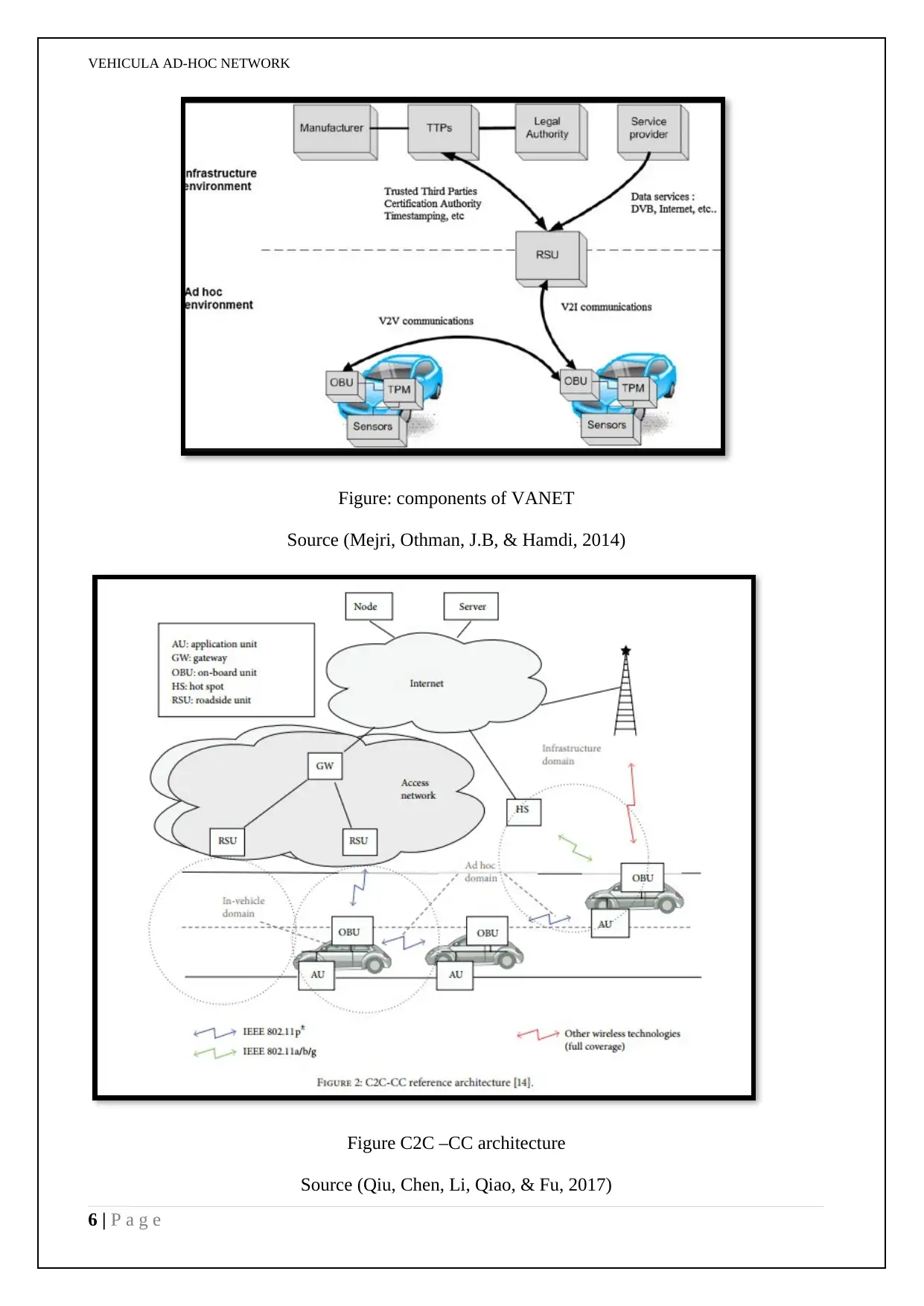
VEHICULA AD-HOC NETWORK
Figure: components of VANET
Source (Mejri, Othman, J.B, & Hamdi, 2014)
Figure C2C –CC architecture
Source (Qiu, Chen, Li, Qiao, & Fu, 2017)
6 | P a g e
Figure: components of VANET
Source (Mejri, Othman, J.B, & Hamdi, 2014)
Figure C2C –CC architecture
Source (Qiu, Chen, Li, Qiao, & Fu, 2017)
6 | P a g e
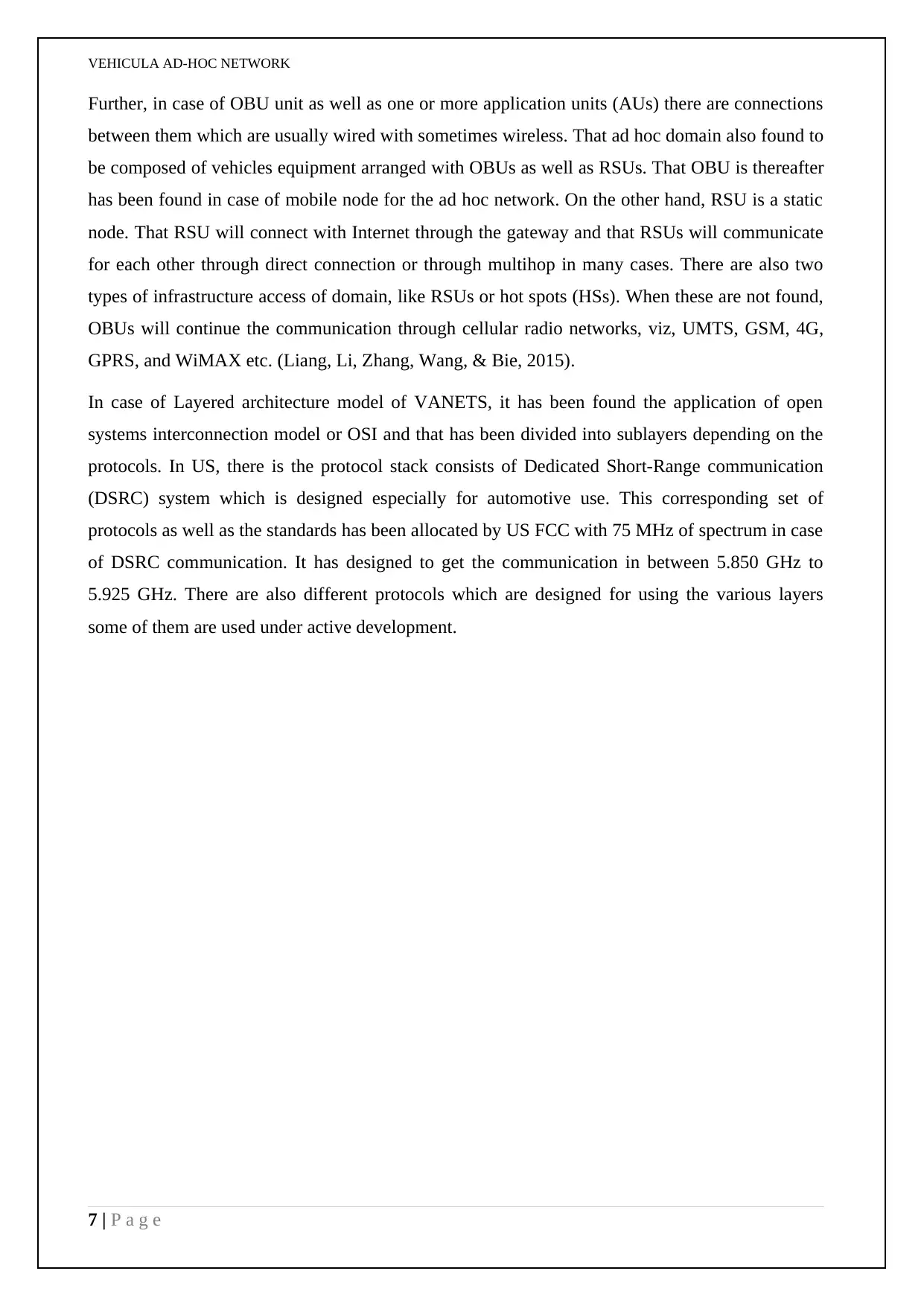
VEHICULA AD-HOC NETWORK
Further, in case of OBU unit as well as one or more application units (AUs) there are connections
between them which are usually wired with sometimes wireless. That ad hoc domain also found to
be composed of vehicles equipment arranged with OBUs as well as RSUs. That OBU is thereafter
has been found in case of mobile node for the ad hoc network. On the other hand, RSU is a static
node. That RSU will connect with Internet through the gateway and that RSUs will communicate
for each other through direct connection or through multihop in many cases. There are also two
types of infrastructure access of domain, like RSUs or hot spots (HSs). When these are not found,
OBUs will continue the communication through cellular radio networks, viz, UMTS, GSM, 4G,
GPRS, and WiMAX etc. (Liang, Li, Zhang, Wang, & Bie, 2015).
In case of Layered architecture model of VANETS, it has been found the application of open
systems interconnection model or OSI and that has been divided into sublayers depending on the
protocols. In US, there is the protocol stack consists of Dedicated Short-Range communication
(DSRC) system which is designed especially for automotive use. This corresponding set of
protocols as well as the standards has been allocated by US FCC with 75 MHz of spectrum in case
of DSRC communication. It has designed to get the communication in between 5.850 GHz to
5.925 GHz. There are also different protocols which are designed for using the various layers
some of them are used under active development.
7 | P a g e
Further, in case of OBU unit as well as one or more application units (AUs) there are connections
between them which are usually wired with sometimes wireless. That ad hoc domain also found to
be composed of vehicles equipment arranged with OBUs as well as RSUs. That OBU is thereafter
has been found in case of mobile node for the ad hoc network. On the other hand, RSU is a static
node. That RSU will connect with Internet through the gateway and that RSUs will communicate
for each other through direct connection or through multihop in many cases. There are also two
types of infrastructure access of domain, like RSUs or hot spots (HSs). When these are not found,
OBUs will continue the communication through cellular radio networks, viz, UMTS, GSM, 4G,
GPRS, and WiMAX etc. (Liang, Li, Zhang, Wang, & Bie, 2015).
In case of Layered architecture model of VANETS, it has been found the application of open
systems interconnection model or OSI and that has been divided into sublayers depending on the
protocols. In US, there is the protocol stack consists of Dedicated Short-Range communication
(DSRC) system which is designed especially for automotive use. This corresponding set of
protocols as well as the standards has been allocated by US FCC with 75 MHz of spectrum in case
of DSRC communication. It has designed to get the communication in between 5.850 GHz to
5.925 GHz. There are also different protocols which are designed for using the various layers
some of them are used under active development.
7 | P a g e
Secure Best Marks with AI Grader
Need help grading? Try our AI Grader for instant feedback on your assignments.
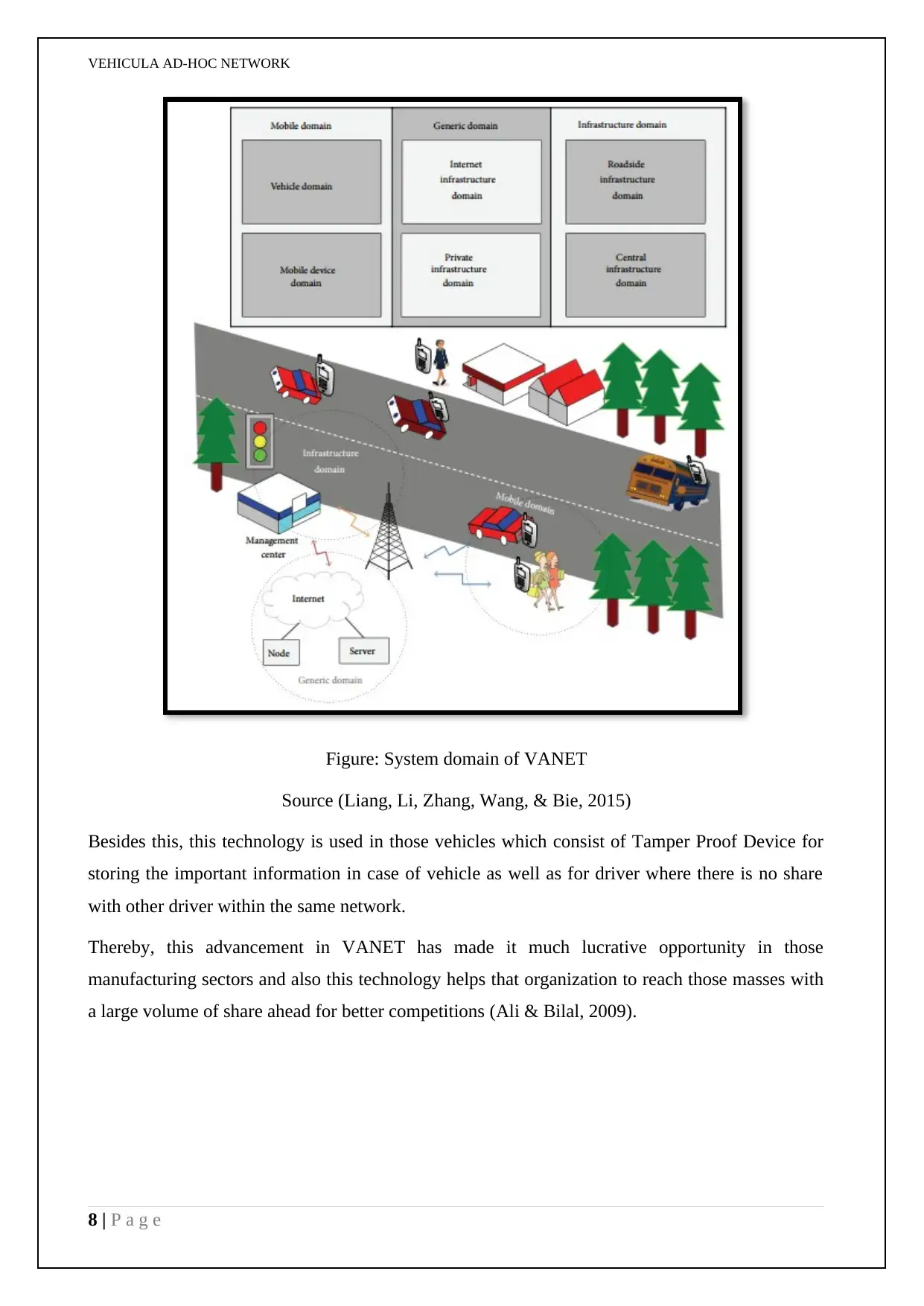
VEHICULA AD-HOC NETWORK
Figure: System domain of VANET
Source (Liang, Li, Zhang, Wang, & Bie, 2015)
Besides this, this technology is used in those vehicles which consist of Tamper Proof Device for
storing the important information in case of vehicle as well as for driver where there is no share
with other driver within the same network.
Thereby, this advancement in VANET has made it much lucrative opportunity in those
manufacturing sectors and also this technology helps that organization to reach those masses with
a large volume of share ahead for better competitions (Ali & Bilal, 2009).
8 | P a g e
Figure: System domain of VANET
Source (Liang, Li, Zhang, Wang, & Bie, 2015)
Besides this, this technology is used in those vehicles which consist of Tamper Proof Device for
storing the important information in case of vehicle as well as for driver where there is no share
with other driver within the same network.
Thereby, this advancement in VANET has made it much lucrative opportunity in those
manufacturing sectors and also this technology helps that organization to reach those masses with
a large volume of share ahead for better competitions (Ali & Bilal, 2009).
8 | P a g e
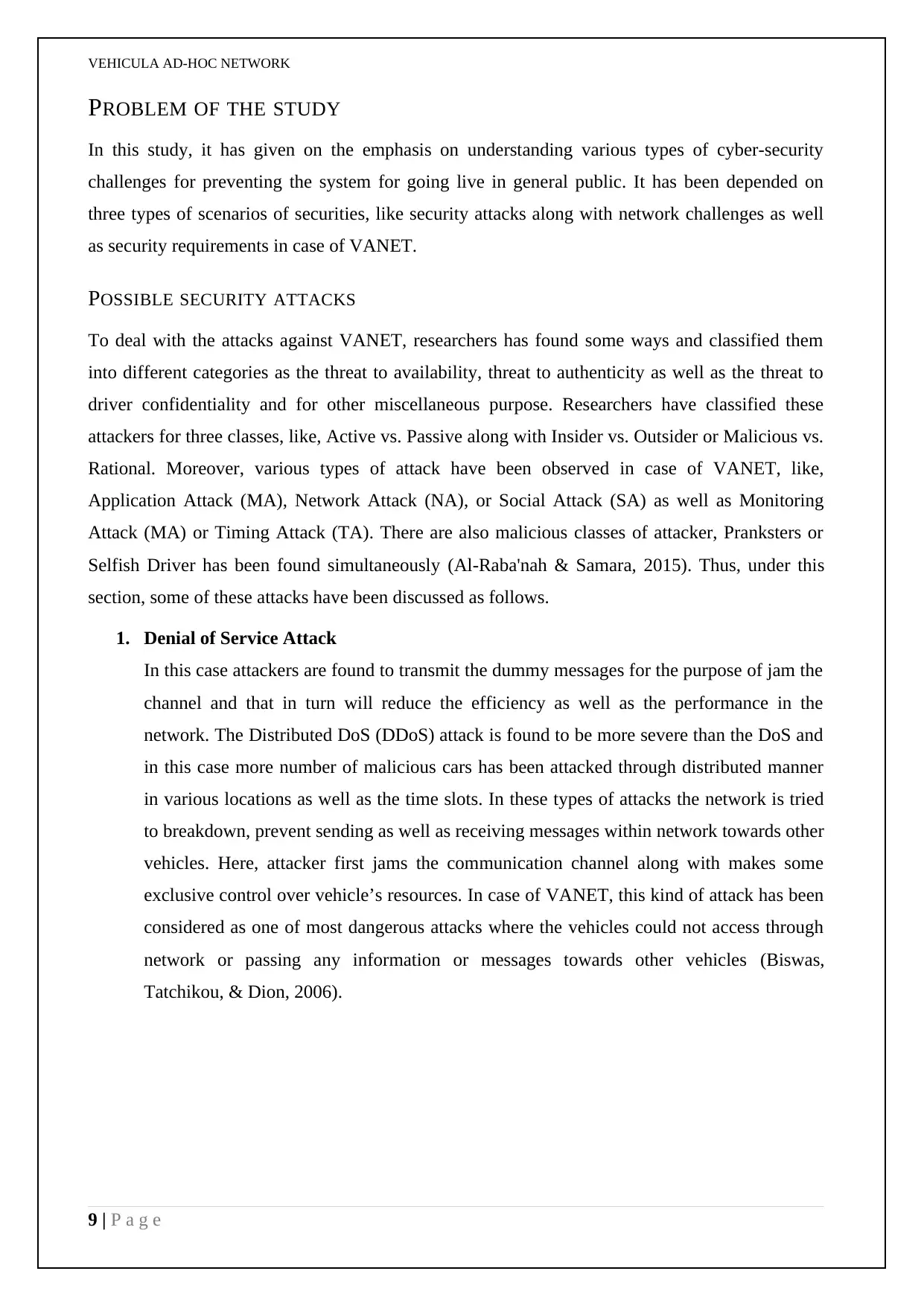
VEHICULA AD-HOC NETWORK
PROBLEM OF THE STUDY
In this study, it has given on the emphasis on understanding various types of cyber-security
challenges for preventing the system for going live in general public. It has been depended on
three types of scenarios of securities, like security attacks along with network challenges as well
as security requirements in case of VANET.
POSSIBLE SECURITY ATTACKS
To deal with the attacks against VANET, researchers has found some ways and classified them
into different categories as the threat to availability, threat to authenticity as well as the threat to
driver confidentiality and for other miscellaneous purpose. Researchers have classified these
attackers for three classes, like, Active vs. Passive along with Insider vs. Outsider or Malicious vs.
Rational. Moreover, various types of attack have been observed in case of VANET, like,
Application Attack (MA), Network Attack (NA), or Social Attack (SA) as well as Monitoring
Attack (MA) or Timing Attack (TA). There are also malicious classes of attacker, Pranksters or
Selfish Driver has been found simultaneously (Al-Raba'nah & Samara, 2015). Thus, under this
section, some of these attacks have been discussed as follows.
1. Denial of Service Attack
In this case attackers are found to transmit the dummy messages for the purpose of jam the
channel and that in turn will reduce the efficiency as well as the performance in the
network. The Distributed DoS (DDoS) attack is found to be more severe than the DoS and
in this case more number of malicious cars has been attacked through distributed manner
in various locations as well as the time slots. In these types of attacks the network is tried
to breakdown, prevent sending as well as receiving messages within network towards other
vehicles. Here, attacker first jams the communication channel along with makes some
exclusive control over vehicle’s resources. In case of VANET, this kind of attack has been
considered as one of most dangerous attacks where the vehicles could not access through
network or passing any information or messages towards other vehicles (Biswas,
Tatchikou, & Dion, 2006).
9 | P a g e
PROBLEM OF THE STUDY
In this study, it has given on the emphasis on understanding various types of cyber-security
challenges for preventing the system for going live in general public. It has been depended on
three types of scenarios of securities, like security attacks along with network challenges as well
as security requirements in case of VANET.
POSSIBLE SECURITY ATTACKS
To deal with the attacks against VANET, researchers has found some ways and classified them
into different categories as the threat to availability, threat to authenticity as well as the threat to
driver confidentiality and for other miscellaneous purpose. Researchers have classified these
attackers for three classes, like, Active vs. Passive along with Insider vs. Outsider or Malicious vs.
Rational. Moreover, various types of attack have been observed in case of VANET, like,
Application Attack (MA), Network Attack (NA), or Social Attack (SA) as well as Monitoring
Attack (MA) or Timing Attack (TA). There are also malicious classes of attacker, Pranksters or
Selfish Driver has been found simultaneously (Al-Raba'nah & Samara, 2015). Thus, under this
section, some of these attacks have been discussed as follows.
1. Denial of Service Attack
In this case attackers are found to transmit the dummy messages for the purpose of jam the
channel and that in turn will reduce the efficiency as well as the performance in the
network. The Distributed DoS (DDoS) attack is found to be more severe than the DoS and
in this case more number of malicious cars has been attacked through distributed manner
in various locations as well as the time slots. In these types of attacks the network is tried
to breakdown, prevent sending as well as receiving messages within network towards other
vehicles. Here, attacker first jams the communication channel along with makes some
exclusive control over vehicle’s resources. In case of VANET, this kind of attack has been
considered as one of most dangerous attacks where the vehicles could not access through
network or passing any information or messages towards other vehicles (Biswas,
Tatchikou, & Dion, 2006).
9 | P a g e
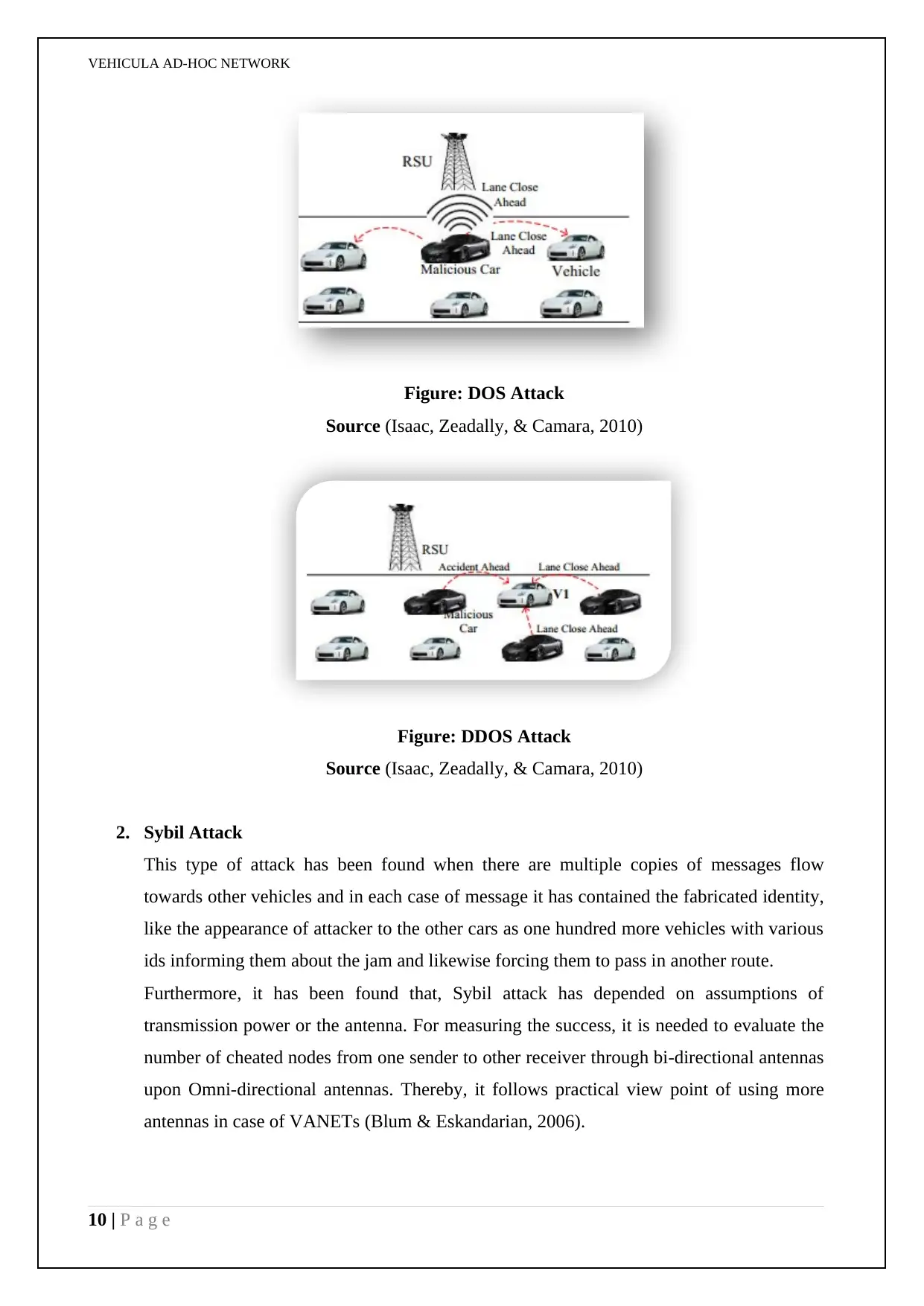
VEHICULA AD-HOC NETWORK
Figure: DOS Attack
Source (Isaac, Zeadally, & Camara, 2010)
Figure: DDOS Attack
Source (Isaac, Zeadally, & Camara, 2010)
2. Sybil Attack
This type of attack has been found when there are multiple copies of messages flow
towards other vehicles and in each case of message it has contained the fabricated identity,
like the appearance of attacker to the other cars as one hundred more vehicles with various
ids informing them about the jam and likewise forcing them to pass in another route.
Furthermore, it has been found that, Sybil attack has depended on assumptions of
transmission power or the antenna. For measuring the success, it is needed to evaluate the
number of cheated nodes from one sender to other receiver through bi-directional antennas
upon Omni-directional antennas. Thereby, it follows practical view point of using more
antennas in case of VANETs (Blum & Eskandarian, 2006).
10 | P a g e
Figure: DOS Attack
Source (Isaac, Zeadally, & Camara, 2010)
Figure: DDOS Attack
Source (Isaac, Zeadally, & Camara, 2010)
2. Sybil Attack
This type of attack has been found when there are multiple copies of messages flow
towards other vehicles and in each case of message it has contained the fabricated identity,
like the appearance of attacker to the other cars as one hundred more vehicles with various
ids informing them about the jam and likewise forcing them to pass in another route.
Furthermore, it has been found that, Sybil attack has depended on assumptions of
transmission power or the antenna. For measuring the success, it is needed to evaluate the
number of cheated nodes from one sender to other receiver through bi-directional antennas
upon Omni-directional antennas. Thereby, it follows practical view point of using more
antennas in case of VANETs (Blum & Eskandarian, 2006).
10 | P a g e
Paraphrase This Document
Need a fresh take? Get an instant paraphrase of this document with our AI Paraphraser
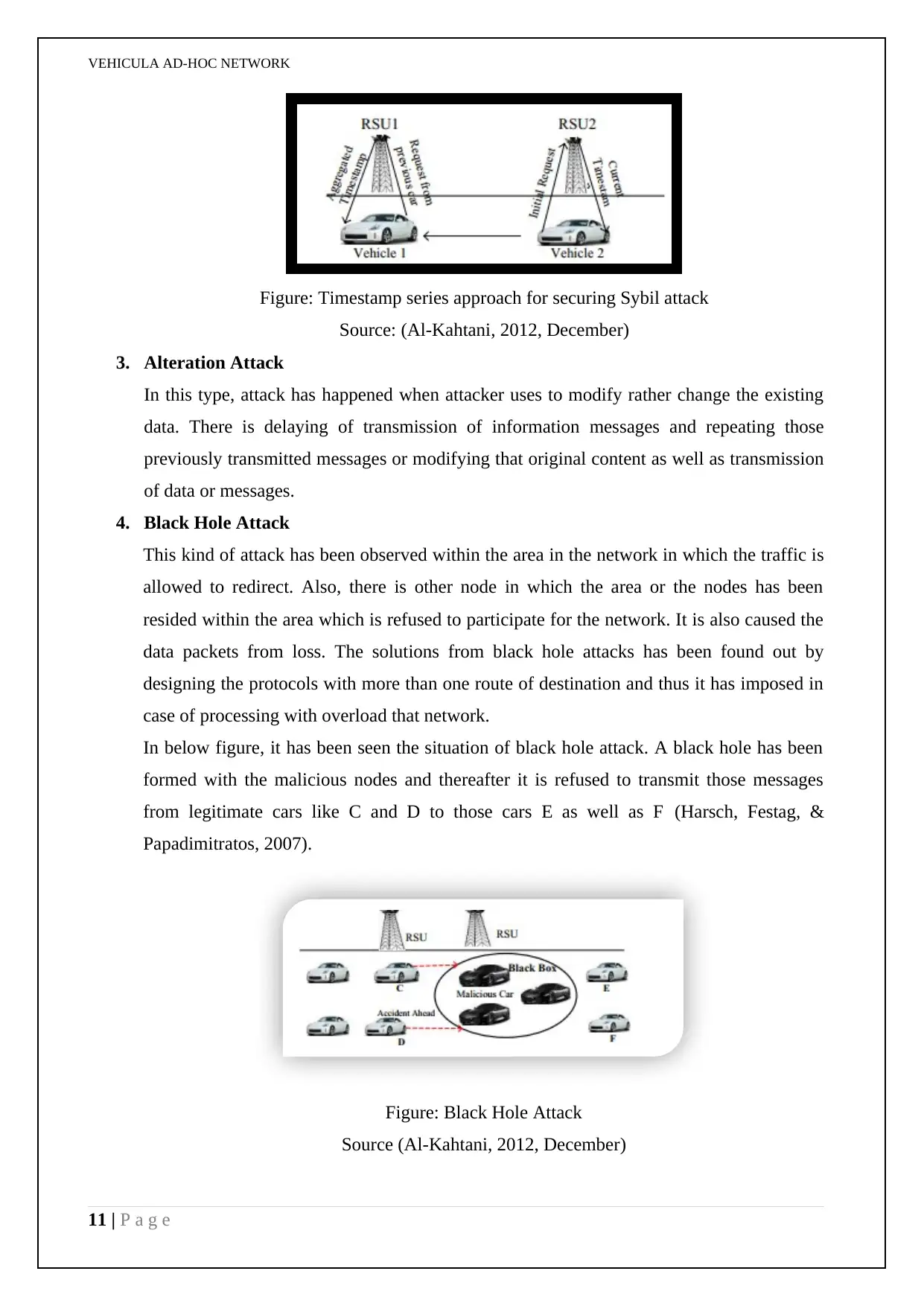
VEHICULA AD-HOC NETWORK
Figure: Timestamp series approach for securing Sybil attack
Source: (Al-Kahtani, 2012, December)
3. Alteration Attack
In this type, attack has happened when attacker uses to modify rather change the existing
data. There is delaying of transmission of information messages and repeating those
previously transmitted messages or modifying that original content as well as transmission
of data or messages.
4. Black Hole Attack
This kind of attack has been observed within the area in the network in which the traffic is
allowed to redirect. Also, there is other node in which the area or the nodes has been
resided within the area which is refused to participate for the network. It is also caused the
data packets from loss. The solutions from black hole attacks has been found out by
designing the protocols with more than one route of destination and thus it has imposed in
case of processing with overload that network.
In below figure, it has been seen the situation of black hole attack. A black hole has been
formed with the malicious nodes and thereafter it is refused to transmit those messages
from legitimate cars like C and D to those cars E as well as F (Harsch, Festag, &
Papadimitratos, 2007).
Figure: Black Hole Attack
Source (Al-Kahtani, 2012, December)
11 | P a g e
Figure: Timestamp series approach for securing Sybil attack
Source: (Al-Kahtani, 2012, December)
3. Alteration Attack
In this type, attack has happened when attacker uses to modify rather change the existing
data. There is delaying of transmission of information messages and repeating those
previously transmitted messages or modifying that original content as well as transmission
of data or messages.
4. Black Hole Attack
This kind of attack has been observed within the area in the network in which the traffic is
allowed to redirect. Also, there is other node in which the area or the nodes has been
resided within the area which is refused to participate for the network. It is also caused the
data packets from loss. The solutions from black hole attacks has been found out by
designing the protocols with more than one route of destination and thus it has imposed in
case of processing with overload that network.
In below figure, it has been seen the situation of black hole attack. A black hole has been
formed with the malicious nodes and thereafter it is refused to transmit those messages
from legitimate cars like C and D to those cars E as well as F (Harsch, Festag, &
Papadimitratos, 2007).
Figure: Black Hole Attack
Source (Al-Kahtani, 2012, December)
11 | P a g e
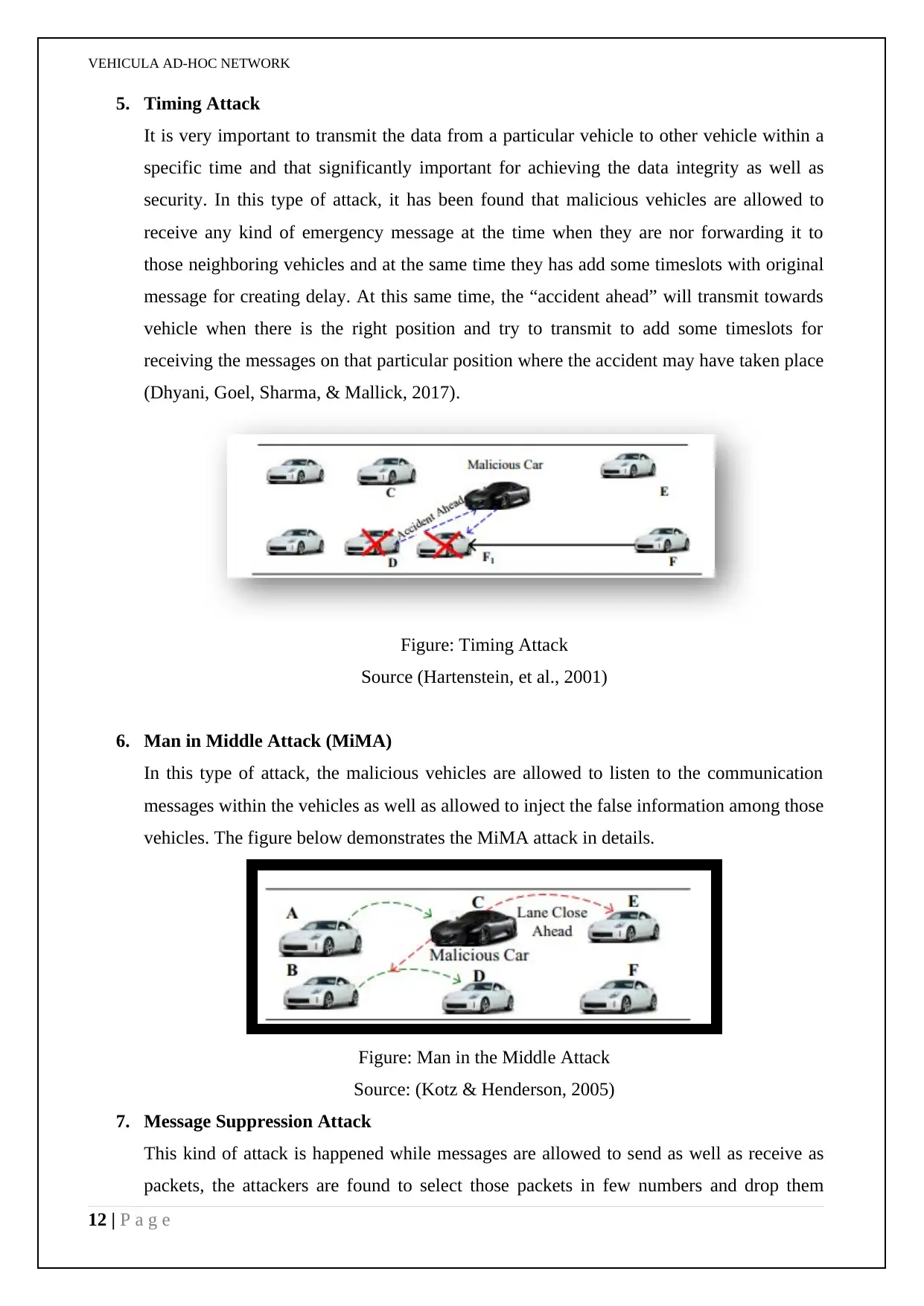
VEHICULA AD-HOC NETWORK
5. Timing Attack
It is very important to transmit the data from a particular vehicle to other vehicle within a
specific time and that significantly important for achieving the data integrity as well as
security. In this type of attack, it has been found that malicious vehicles are allowed to
receive any kind of emergency message at the time when they are nor forwarding it to
those neighboring vehicles and at the same time they has add some timeslots with original
message for creating delay. At this same time, the “accident ahead” will transmit towards
vehicle when there is the right position and try to transmit to add some timeslots for
receiving the messages on that particular position where the accident may have taken place
(Dhyani, Goel, Sharma, & Mallick, 2017).
Figure: Timing Attack
Source (Hartenstein, et al., 2001)
6. Man in Middle Attack (MiMA)
In this type of attack, the malicious vehicles are allowed to listen to the communication
messages within the vehicles as well as allowed to inject the false information among those
vehicles. The figure below demonstrates the MiMA attack in details.
Figure: Man in the Middle Attack
Source: (Kotz & Henderson, 2005)
7. Message Suppression Attack
This kind of attack is happened while messages are allowed to send as well as receive as
packets, the attackers are found to select those packets in few numbers and drop them
12 | P a g e
5. Timing Attack
It is very important to transmit the data from a particular vehicle to other vehicle within a
specific time and that significantly important for achieving the data integrity as well as
security. In this type of attack, it has been found that malicious vehicles are allowed to
receive any kind of emergency message at the time when they are nor forwarding it to
those neighboring vehicles and at the same time they has add some timeslots with original
message for creating delay. At this same time, the “accident ahead” will transmit towards
vehicle when there is the right position and try to transmit to add some timeslots for
receiving the messages on that particular position where the accident may have taken place
(Dhyani, Goel, Sharma, & Mallick, 2017).
Figure: Timing Attack
Source (Hartenstein, et al., 2001)
6. Man in Middle Attack (MiMA)
In this type of attack, the malicious vehicles are allowed to listen to the communication
messages within the vehicles as well as allowed to inject the false information among those
vehicles. The figure below demonstrates the MiMA attack in details.
Figure: Man in the Middle Attack
Source: (Kotz & Henderson, 2005)
7. Message Suppression Attack
This kind of attack is happened while messages are allowed to send as well as receive as
packets, the attackers are found to select those packets in few numbers and drop them
12 | P a g e
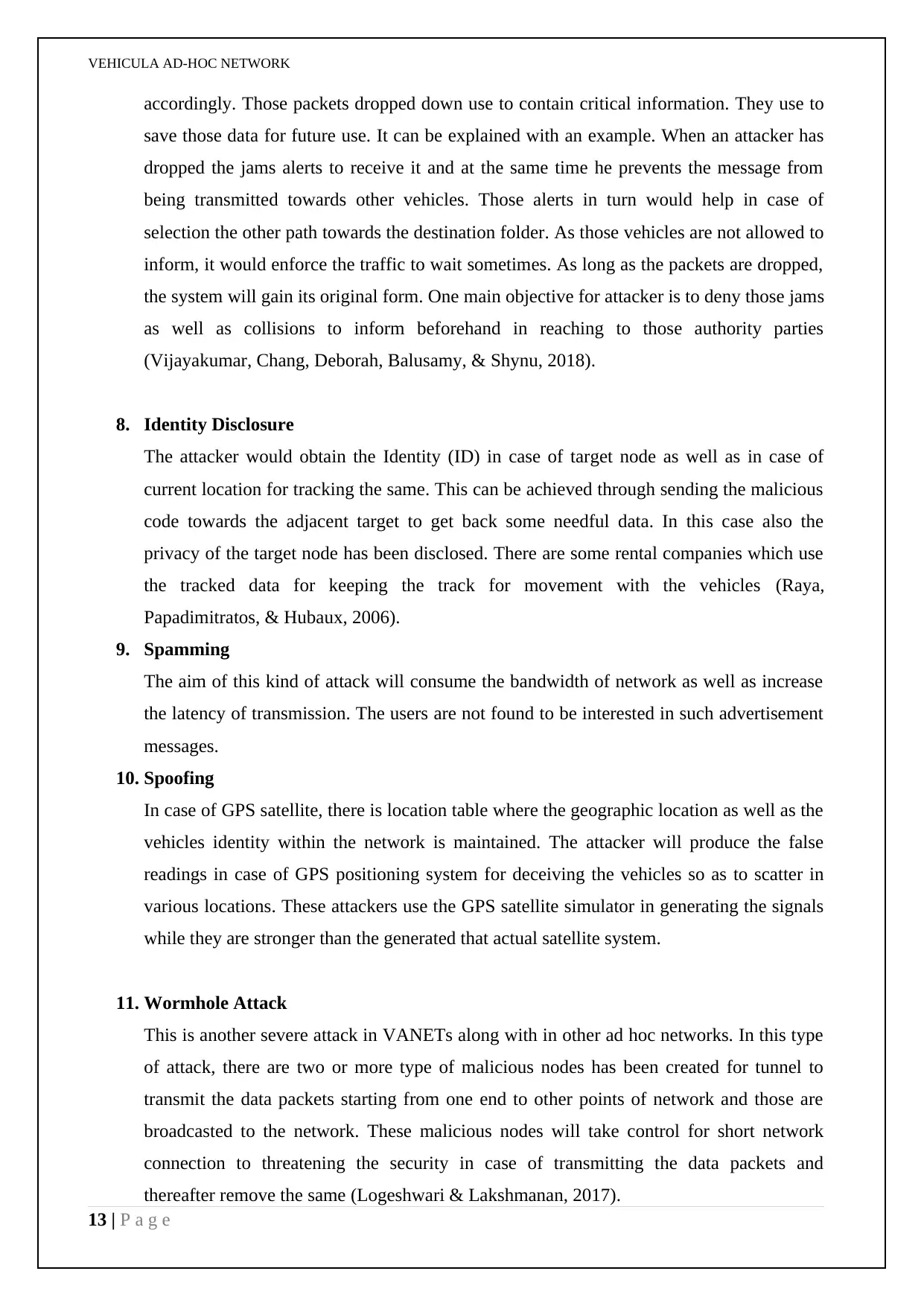
VEHICULA AD-HOC NETWORK
accordingly. Those packets dropped down use to contain critical information. They use to
save those data for future use. It can be explained with an example. When an attacker has
dropped the jams alerts to receive it and at the same time he prevents the message from
being transmitted towards other vehicles. Those alerts in turn would help in case of
selection the other path towards the destination folder. As those vehicles are not allowed to
inform, it would enforce the traffic to wait sometimes. As long as the packets are dropped,
the system will gain its original form. One main objective for attacker is to deny those jams
as well as collisions to inform beforehand in reaching to those authority parties
(Vijayakumar, Chang, Deborah, Balusamy, & Shynu, 2018).
8. Identity Disclosure
The attacker would obtain the Identity (ID) in case of target node as well as in case of
current location for tracking the same. This can be achieved through sending the malicious
code towards the adjacent target to get back some needful data. In this case also the
privacy of the target node has been disclosed. There are some rental companies which use
the tracked data for keeping the track for movement with the vehicles (Raya,
Papadimitratos, & Hubaux, 2006).
9. Spamming
The aim of this kind of attack will consume the bandwidth of network as well as increase
the latency of transmission. The users are not found to be interested in such advertisement
messages.
10. Spoofing
In case of GPS satellite, there is location table where the geographic location as well as the
vehicles identity within the network is maintained. The attacker will produce the false
readings in case of GPS positioning system for deceiving the vehicles so as to scatter in
various locations. These attackers use the GPS satellite simulator in generating the signals
while they are stronger than the generated that actual satellite system.
11. Wormhole Attack
This is another severe attack in VANETs along with in other ad hoc networks. In this type
of attack, there are two or more type of malicious nodes has been created for tunnel to
transmit the data packets starting from one end to other points of network and those are
broadcasted to the network. These malicious nodes will take control for short network
connection to threatening the security in case of transmitting the data packets and
thereafter remove the same (Logeshwari & Lakshmanan, 2017).
13 | P a g e
accordingly. Those packets dropped down use to contain critical information. They use to
save those data for future use. It can be explained with an example. When an attacker has
dropped the jams alerts to receive it and at the same time he prevents the message from
being transmitted towards other vehicles. Those alerts in turn would help in case of
selection the other path towards the destination folder. As those vehicles are not allowed to
inform, it would enforce the traffic to wait sometimes. As long as the packets are dropped,
the system will gain its original form. One main objective for attacker is to deny those jams
as well as collisions to inform beforehand in reaching to those authority parties
(Vijayakumar, Chang, Deborah, Balusamy, & Shynu, 2018).
8. Identity Disclosure
The attacker would obtain the Identity (ID) in case of target node as well as in case of
current location for tracking the same. This can be achieved through sending the malicious
code towards the adjacent target to get back some needful data. In this case also the
privacy of the target node has been disclosed. There are some rental companies which use
the tracked data for keeping the track for movement with the vehicles (Raya,
Papadimitratos, & Hubaux, 2006).
9. Spamming
The aim of this kind of attack will consume the bandwidth of network as well as increase
the latency of transmission. The users are not found to be interested in such advertisement
messages.
10. Spoofing
In case of GPS satellite, there is location table where the geographic location as well as the
vehicles identity within the network is maintained. The attacker will produce the false
readings in case of GPS positioning system for deceiving the vehicles so as to scatter in
various locations. These attackers use the GPS satellite simulator in generating the signals
while they are stronger than the generated that actual satellite system.
11. Wormhole Attack
This is another severe attack in VANETs along with in other ad hoc networks. In this type
of attack, there are two or more type of malicious nodes has been created for tunnel to
transmit the data packets starting from one end to other points of network and those are
broadcasted to the network. These malicious nodes will take control for short network
connection to threatening the security in case of transmitting the data packets and
thereafter remove the same (Logeshwari & Lakshmanan, 2017).
13 | P a g e
Secure Best Marks with AI Grader
Need help grading? Try our AI Grader for instant feedback on your assignments.
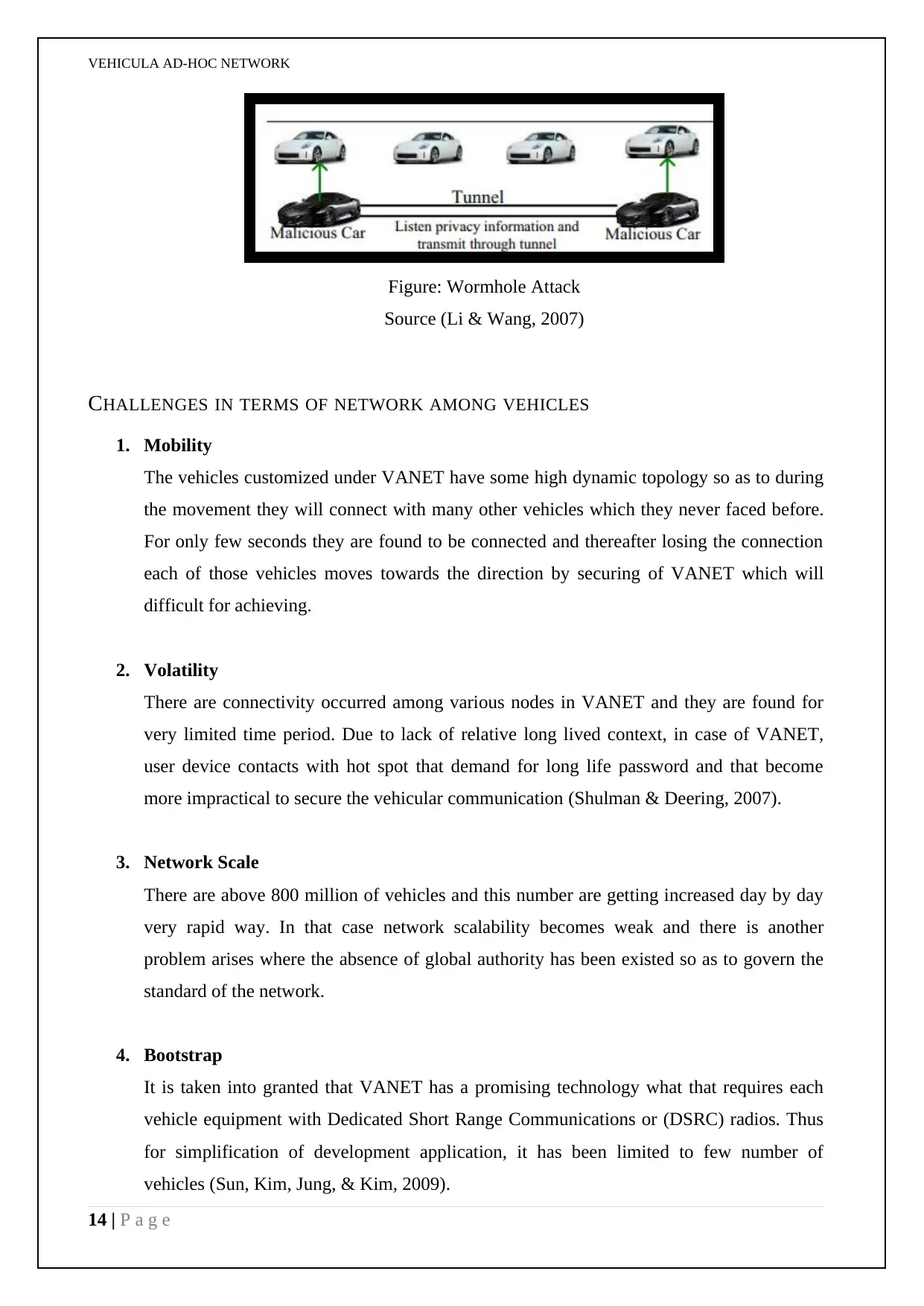
VEHICULA AD-HOC NETWORK
Figure: Wormhole Attack
Source (Li & Wang, 2007)
CHALLENGES IN TERMS OF NETWORK AMONG VEHICLES
1. Mobility
The vehicles customized under VANET have some high dynamic topology so as to during
the movement they will connect with many other vehicles which they never faced before.
For only few seconds they are found to be connected and thereafter losing the connection
each of those vehicles moves towards the direction by securing of VANET which will
difficult for achieving.
2. Volatility
There are connectivity occurred among various nodes in VANET and they are found for
very limited time period. Due to lack of relative long lived context, in case of VANET,
user device contacts with hot spot that demand for long life password and that become
more impractical to secure the vehicular communication (Shulman & Deering, 2007).
3. Network Scale
There are above 800 million of vehicles and this number are getting increased day by day
very rapid way. In that case network scalability becomes weak and there is another
problem arises where the absence of global authority has been existed so as to govern the
standard of the network.
4. Bootstrap
It is taken into granted that VANET has a promising technology what that requires each
vehicle equipment with Dedicated Short Range Communications or (DSRC) radios. Thus
for simplification of development application, it has been limited to few number of
vehicles (Sun, Kim, Jung, & Kim, 2009).
14 | P a g e
Figure: Wormhole Attack
Source (Li & Wang, 2007)
CHALLENGES IN TERMS OF NETWORK AMONG VEHICLES
1. Mobility
The vehicles customized under VANET have some high dynamic topology so as to during
the movement they will connect with many other vehicles which they never faced before.
For only few seconds they are found to be connected and thereafter losing the connection
each of those vehicles moves towards the direction by securing of VANET which will
difficult for achieving.
2. Volatility
There are connectivity occurred among various nodes in VANET and they are found for
very limited time period. Due to lack of relative long lived context, in case of VANET,
user device contacts with hot spot that demand for long life password and that become
more impractical to secure the vehicular communication (Shulman & Deering, 2007).
3. Network Scale
There are above 800 million of vehicles and this number are getting increased day by day
very rapid way. In that case network scalability becomes weak and there is another
problem arises where the absence of global authority has been existed so as to govern the
standard of the network.
4. Bootstrap
It is taken into granted that VANET has a promising technology what that requires each
vehicle equipment with Dedicated Short Range Communications or (DSRC) radios. Thus
for simplification of development application, it has been limited to few number of
vehicles (Sun, Kim, Jung, & Kim, 2009).
14 | P a g e
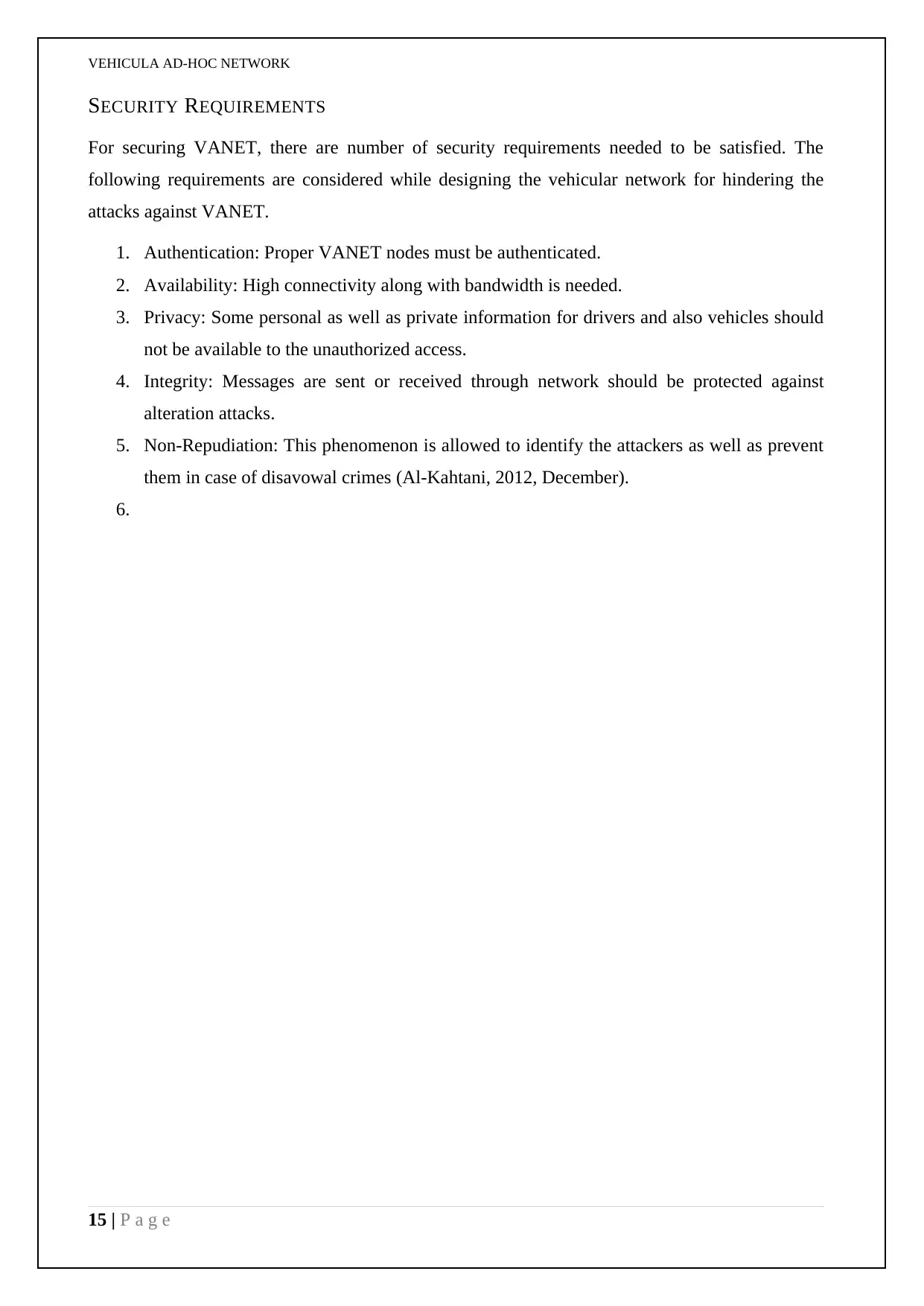
VEHICULA AD-HOC NETWORK
SECURITY REQUIREMENTS
For securing VANET, there are number of security requirements needed to be satisfied. The
following requirements are considered while designing the vehicular network for hindering the
attacks against VANET.
1. Authentication: Proper VANET nodes must be authenticated.
2. Availability: High connectivity along with bandwidth is needed.
3. Privacy: Some personal as well as private information for drivers and also vehicles should
not be available to the unauthorized access.
4. Integrity: Messages are sent or received through network should be protected against
alteration attacks.
5. Non-Repudiation: This phenomenon is allowed to identify the attackers as well as prevent
them in case of disavowal crimes (Al-Kahtani, 2012, December).
6.
15 | P a g e
SECURITY REQUIREMENTS
For securing VANET, there are number of security requirements needed to be satisfied. The
following requirements are considered while designing the vehicular network for hindering the
attacks against VANET.
1. Authentication: Proper VANET nodes must be authenticated.
2. Availability: High connectivity along with bandwidth is needed.
3. Privacy: Some personal as well as private information for drivers and also vehicles should
not be available to the unauthorized access.
4. Integrity: Messages are sent or received through network should be protected against
alteration attacks.
5. Non-Repudiation: This phenomenon is allowed to identify the attackers as well as prevent
them in case of disavowal crimes (Al-Kahtani, 2012, December).
6.
15 | P a g e

VEHICULA AD-HOC NETWORK
FUTURE RESEARCH AND PROSPECTIVE
It has been found that VANETs is becoming more popular in case of transportation systems where
they are allowed to provide the safety in road, better traffic management as well as access of
internet in highway along with the distribution of safety of information for drivers as well as
passengers. However, there is the great challenge which has been implemented the value-added
services in VANETs for preventing the intruder vehicles as well as several security attacks. So, to
provide proper security together with privacy in VANETs has been considered as the most
significant research issue in this field.
In addition with this, mobility for the vehicles along with their dynamic nature for the network has
been imposed with great challenge for eliminating the malicious vehicles as well as designs the
secured data transmission protocols. An extensive research have been conducted for providing the
security as well as the privacy in VANETs where most of the approaches has been considered in
reducing the computational as well as communication overhead through processing the delay with
authentication between the source as well as destination vehicles (Llavendhan & Saruladha, 2018).
Furthermore, the following aspects are needed to be considered for future research in this field:
1. It is required to distribute the certificates securely through validating them in rapid manner
with computational efficiency and that has given more attention while securing the
protocols for VANETs.
2. The mobility pattern for vehicles has to be determined and that is needed to link with the
malicious vehicles as a basic block in potential research for providing security as well as
privacy in VANETs.
3. The MAC address is required to change together with the pseudonyms as there should be
change of IP address. Or in other ways, the adversaries may easily track the records of
vehicle through this MAC address (Torre, Rad, & Choo, 2018).
16 | P a g e
FUTURE RESEARCH AND PROSPECTIVE
It has been found that VANETs is becoming more popular in case of transportation systems where
they are allowed to provide the safety in road, better traffic management as well as access of
internet in highway along with the distribution of safety of information for drivers as well as
passengers. However, there is the great challenge which has been implemented the value-added
services in VANETs for preventing the intruder vehicles as well as several security attacks. So, to
provide proper security together with privacy in VANETs has been considered as the most
significant research issue in this field.
In addition with this, mobility for the vehicles along with their dynamic nature for the network has
been imposed with great challenge for eliminating the malicious vehicles as well as designs the
secured data transmission protocols. An extensive research have been conducted for providing the
security as well as the privacy in VANETs where most of the approaches has been considered in
reducing the computational as well as communication overhead through processing the delay with
authentication between the source as well as destination vehicles (Llavendhan & Saruladha, 2018).
Furthermore, the following aspects are needed to be considered for future research in this field:
1. It is required to distribute the certificates securely through validating them in rapid manner
with computational efficiency and that has given more attention while securing the
protocols for VANETs.
2. The mobility pattern for vehicles has to be determined and that is needed to link with the
malicious vehicles as a basic block in potential research for providing security as well as
privacy in VANETs.
3. The MAC address is required to change together with the pseudonyms as there should be
change of IP address. Or in other ways, the adversaries may easily track the records of
vehicle through this MAC address (Torre, Rad, & Choo, 2018).
16 | P a g e
Paraphrase This Document
Need a fresh take? Get an instant paraphrase of this document with our AI Paraphraser

VEHICULA AD-HOC NETWORK
CONCLUSION
From the above discussion, it is thus concluded that understanding of VANET is much important
job as it is related with large potential in case of transportation and thus contains huge challenges
in the field of security. There should be an appropriate consideration of all kind of security
challenges and with proper handling, it can only be possible to regularize the system of VANET
for hitting the road among public.
17 | P a g e
CONCLUSION
From the above discussion, it is thus concluded that understanding of VANET is much important
job as it is related with large potential in case of transportation and thus contains huge challenges
in the field of security. There should be an appropriate consideration of all kind of security
challenges and with proper handling, it can only be possible to regularize the system of VANET
for hitting the road among public.
17 | P a g e
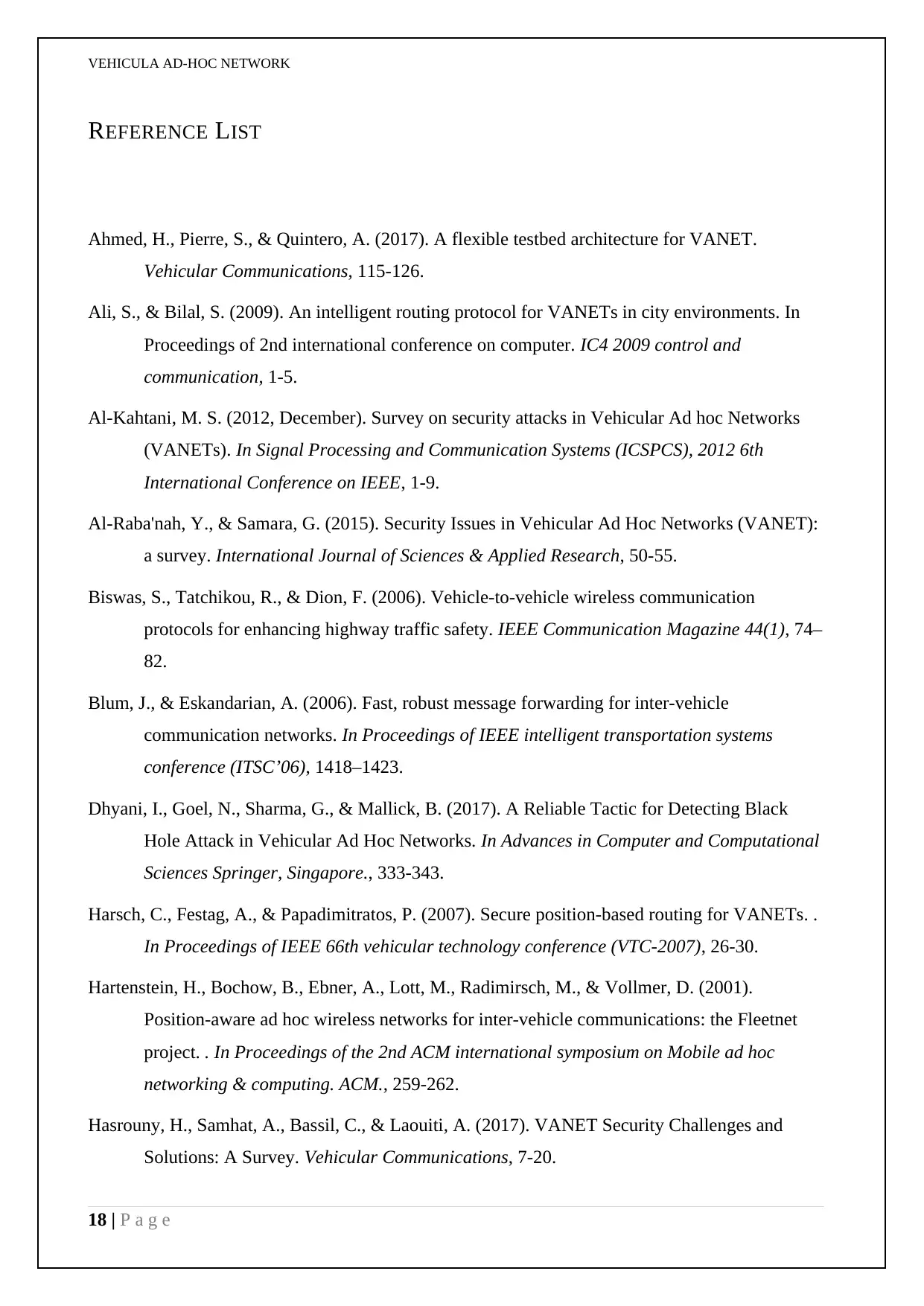
VEHICULA AD-HOC NETWORK
REFERENCE LIST
Ahmed, H., Pierre, S., & Quintero, A. (2017). A flexible testbed architecture for VANET.
Vehicular Communications, 115-126.
Ali, S., & Bilal, S. (2009). An intelligent routing protocol for VANETs in city environments. In
Proceedings of 2nd international conference on computer. IC4 2009 control and
communication, 1-5.
Al-Kahtani, M. S. (2012, December). Survey on security attacks in Vehicular Ad hoc Networks
(VANETs). In Signal Processing and Communication Systems (ICSPCS), 2012 6th
International Conference on IEEE, 1-9.
Al-Raba'nah, Y., & Samara, G. (2015). Security Issues in Vehicular Ad Hoc Networks (VANET):
a survey. International Journal of Sciences & Applied Research, 50-55.
Biswas, S., Tatchikou, R., & Dion, F. (2006). Vehicle-to-vehicle wireless communication
protocols for enhancing highway traffic safety. IEEE Communication Magazine 44(1), 74–
82.
Blum, J., & Eskandarian, A. (2006). Fast, robust message forwarding for inter-vehicle
communication networks. In Proceedings of IEEE intelligent transportation systems
conference (ITSC’06), 1418–1423.
Dhyani, I., Goel, N., Sharma, G., & Mallick, B. (2017). A Reliable Tactic for Detecting Black
Hole Attack in Vehicular Ad Hoc Networks. In Advances in Computer and Computational
Sciences Springer, Singapore., 333-343.
Harsch, C., Festag, A., & Papadimitratos, P. (2007). Secure position-based routing for VANETs. .
In Proceedings of IEEE 66th vehicular technology conference (VTC-2007), 26-30.
Hartenstein, H., Bochow, B., Ebner, A., Lott, M., Radimirsch, M., & Vollmer, D. (2001).
Position-aware ad hoc wireless networks for inter-vehicle communications: the Fleetnet
project. . In Proceedings of the 2nd ACM international symposium on Mobile ad hoc
networking & computing. ACM., 259-262.
Hasrouny, H., Samhat, A., Bassil, C., & Laouiti, A. (2017). VANET Security Challenges and
Solutions: A Survey. Vehicular Communications, 7-20.
18 | P a g e
REFERENCE LIST
Ahmed, H., Pierre, S., & Quintero, A. (2017). A flexible testbed architecture for VANET.
Vehicular Communications, 115-126.
Ali, S., & Bilal, S. (2009). An intelligent routing protocol for VANETs in city environments. In
Proceedings of 2nd international conference on computer. IC4 2009 control and
communication, 1-5.
Al-Kahtani, M. S. (2012, December). Survey on security attacks in Vehicular Ad hoc Networks
(VANETs). In Signal Processing and Communication Systems (ICSPCS), 2012 6th
International Conference on IEEE, 1-9.
Al-Raba'nah, Y., & Samara, G. (2015). Security Issues in Vehicular Ad Hoc Networks (VANET):
a survey. International Journal of Sciences & Applied Research, 50-55.
Biswas, S., Tatchikou, R., & Dion, F. (2006). Vehicle-to-vehicle wireless communication
protocols for enhancing highway traffic safety. IEEE Communication Magazine 44(1), 74–
82.
Blum, J., & Eskandarian, A. (2006). Fast, robust message forwarding for inter-vehicle
communication networks. In Proceedings of IEEE intelligent transportation systems
conference (ITSC’06), 1418–1423.
Dhyani, I., Goel, N., Sharma, G., & Mallick, B. (2017). A Reliable Tactic for Detecting Black
Hole Attack in Vehicular Ad Hoc Networks. In Advances in Computer and Computational
Sciences Springer, Singapore., 333-343.
Harsch, C., Festag, A., & Papadimitratos, P. (2007). Secure position-based routing for VANETs. .
In Proceedings of IEEE 66th vehicular technology conference (VTC-2007), 26-30.
Hartenstein, H., Bochow, B., Ebner, A., Lott, M., Radimirsch, M., & Vollmer, D. (2001).
Position-aware ad hoc wireless networks for inter-vehicle communications: the Fleetnet
project. . In Proceedings of the 2nd ACM international symposium on Mobile ad hoc
networking & computing. ACM., 259-262.
Hasrouny, H., Samhat, A., Bassil, C., & Laouiti, A. (2017). VANET Security Challenges and
Solutions: A Survey. Vehicular Communications, 7-20.
18 | P a g e
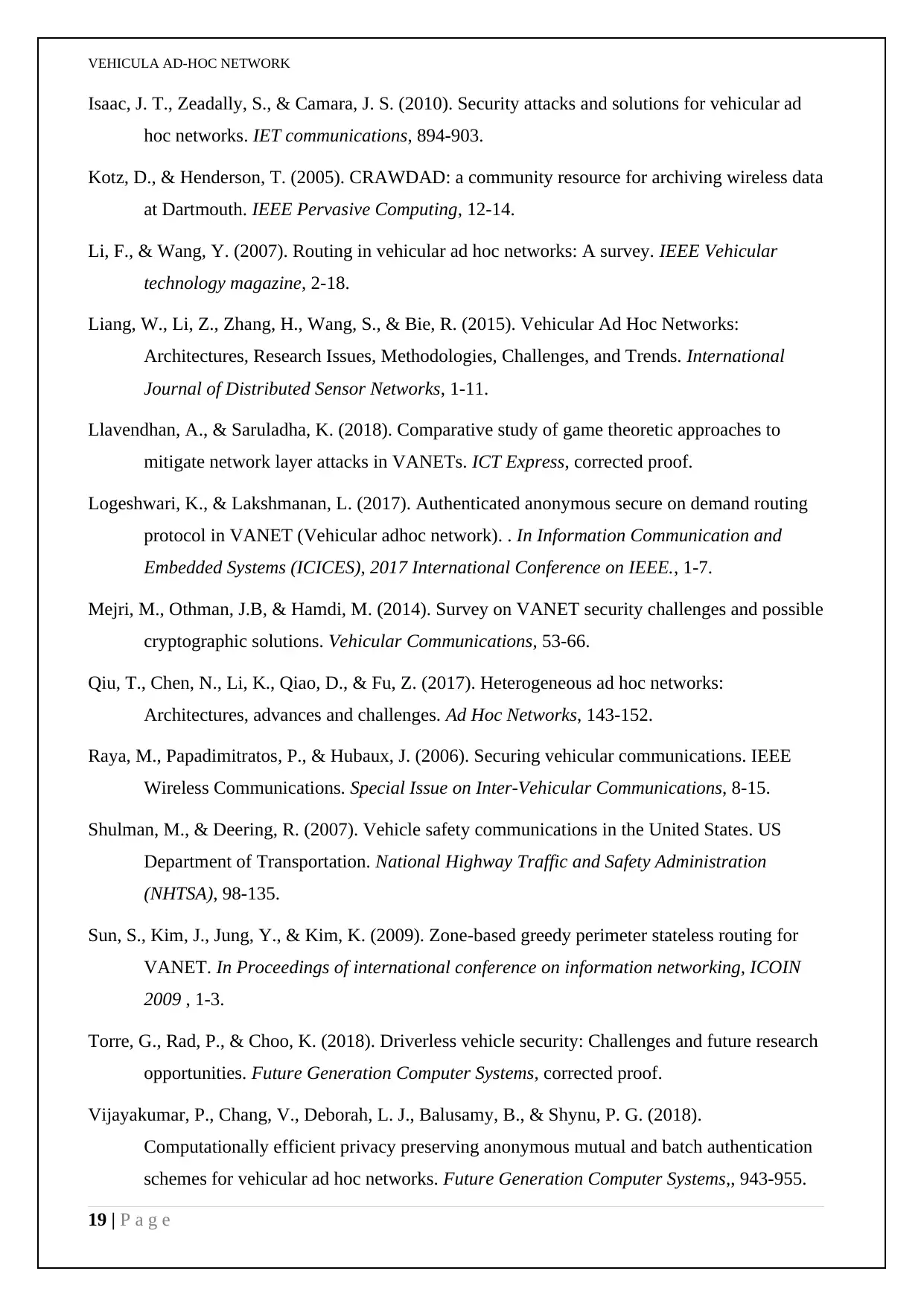
VEHICULA AD-HOC NETWORK
Isaac, J. T., Zeadally, S., & Camara, J. S. (2010). Security attacks and solutions for vehicular ad
hoc networks. IET communications, 894-903.
Kotz, D., & Henderson, T. (2005). CRAWDAD: a community resource for archiving wireless data
at Dartmouth. IEEE Pervasive Computing, 12-14.
Li, F., & Wang, Y. (2007). Routing in vehicular ad hoc networks: A survey. IEEE Vehicular
technology magazine, 2-18.
Liang, W., Li, Z., Zhang, H., Wang, S., & Bie, R. (2015). Vehicular Ad Hoc Networks:
Architectures, Research Issues, Methodologies, Challenges, and Trends. International
Journal of Distributed Sensor Networks, 1-11.
Llavendhan, A., & Saruladha, K. (2018). Comparative study of game theoretic approaches to
mitigate network layer attacks in VANETs. ICT Express, corrected proof.
Logeshwari, K., & Lakshmanan, L. (2017). Authenticated anonymous secure on demand routing
protocol in VANET (Vehicular adhoc network). . In Information Communication and
Embedded Systems (ICICES), 2017 International Conference on IEEE., 1-7.
Mejri, M., Othman, J.B, & Hamdi, M. (2014). Survey on VANET security challenges and possible
cryptographic solutions. Vehicular Communications, 53-66.
Qiu, T., Chen, N., Li, K., Qiao, D., & Fu, Z. (2017). Heterogeneous ad hoc networks:
Architectures, advances and challenges. Ad Hoc Networks, 143-152.
Raya, M., Papadimitratos, P., & Hubaux, J. (2006). Securing vehicular communications. IEEE
Wireless Communications. Special Issue on Inter-Vehicular Communications, 8-15.
Shulman, M., & Deering, R. (2007). Vehicle safety communications in the United States. US
Department of Transportation. National Highway Traffic and Safety Administration
(NHTSA), 98-135.
Sun, S., Kim, J., Jung, Y., & Kim, K. (2009). Zone-based greedy perimeter stateless routing for
VANET. In Proceedings of international conference on information networking, ICOIN
2009 , 1-3.
Torre, G., Rad, P., & Choo, K. (2018). Driverless vehicle security: Challenges and future research
opportunities. Future Generation Computer Systems, corrected proof.
Vijayakumar, P., Chang, V., Deborah, L. J., Balusamy, B., & Shynu, P. G. (2018).
Computationally efficient privacy preserving anonymous mutual and batch authentication
schemes for vehicular ad hoc networks. Future Generation Computer Systems,, 943-955.
19 | P a g e
Isaac, J. T., Zeadally, S., & Camara, J. S. (2010). Security attacks and solutions for vehicular ad
hoc networks. IET communications, 894-903.
Kotz, D., & Henderson, T. (2005). CRAWDAD: a community resource for archiving wireless data
at Dartmouth. IEEE Pervasive Computing, 12-14.
Li, F., & Wang, Y. (2007). Routing in vehicular ad hoc networks: A survey. IEEE Vehicular
technology magazine, 2-18.
Liang, W., Li, Z., Zhang, H., Wang, S., & Bie, R. (2015). Vehicular Ad Hoc Networks:
Architectures, Research Issues, Methodologies, Challenges, and Trends. International
Journal of Distributed Sensor Networks, 1-11.
Llavendhan, A., & Saruladha, K. (2018). Comparative study of game theoretic approaches to
mitigate network layer attacks in VANETs. ICT Express, corrected proof.
Logeshwari, K., & Lakshmanan, L. (2017). Authenticated anonymous secure on demand routing
protocol in VANET (Vehicular adhoc network). . In Information Communication and
Embedded Systems (ICICES), 2017 International Conference on IEEE., 1-7.
Mejri, M., Othman, J.B, & Hamdi, M. (2014). Survey on VANET security challenges and possible
cryptographic solutions. Vehicular Communications, 53-66.
Qiu, T., Chen, N., Li, K., Qiao, D., & Fu, Z. (2017). Heterogeneous ad hoc networks:
Architectures, advances and challenges. Ad Hoc Networks, 143-152.
Raya, M., Papadimitratos, P., & Hubaux, J. (2006). Securing vehicular communications. IEEE
Wireless Communications. Special Issue on Inter-Vehicular Communications, 8-15.
Shulman, M., & Deering, R. (2007). Vehicle safety communications in the United States. US
Department of Transportation. National Highway Traffic and Safety Administration
(NHTSA), 98-135.
Sun, S., Kim, J., Jung, Y., & Kim, K. (2009). Zone-based greedy perimeter stateless routing for
VANET. In Proceedings of international conference on information networking, ICOIN
2009 , 1-3.
Torre, G., Rad, P., & Choo, K. (2018). Driverless vehicle security: Challenges and future research
opportunities. Future Generation Computer Systems, corrected proof.
Vijayakumar, P., Chang, V., Deborah, L. J., Balusamy, B., & Shynu, P. G. (2018).
Computationally efficient privacy preserving anonymous mutual and batch authentication
schemes for vehicular ad hoc networks. Future Generation Computer Systems,, 943-955.
19 | P a g e
1 out of 19
Related Documents
Your All-in-One AI-Powered Toolkit for Academic Success.
+13062052269
info@desklib.com
Available 24*7 on WhatsApp / Email
![[object Object]](/_next/static/media/star-bottom.7253800d.svg)
Unlock your academic potential
© 2024 | Zucol Services PVT LTD | All rights reserved.





